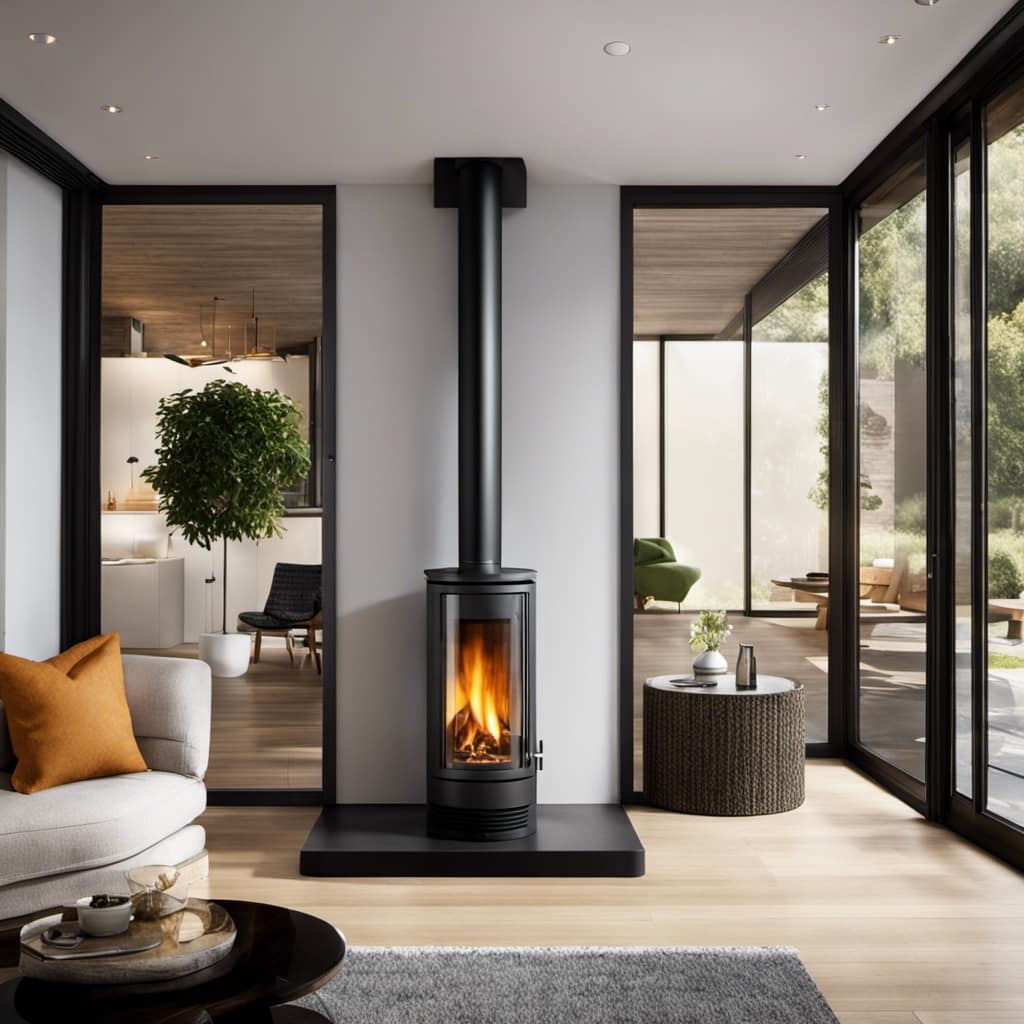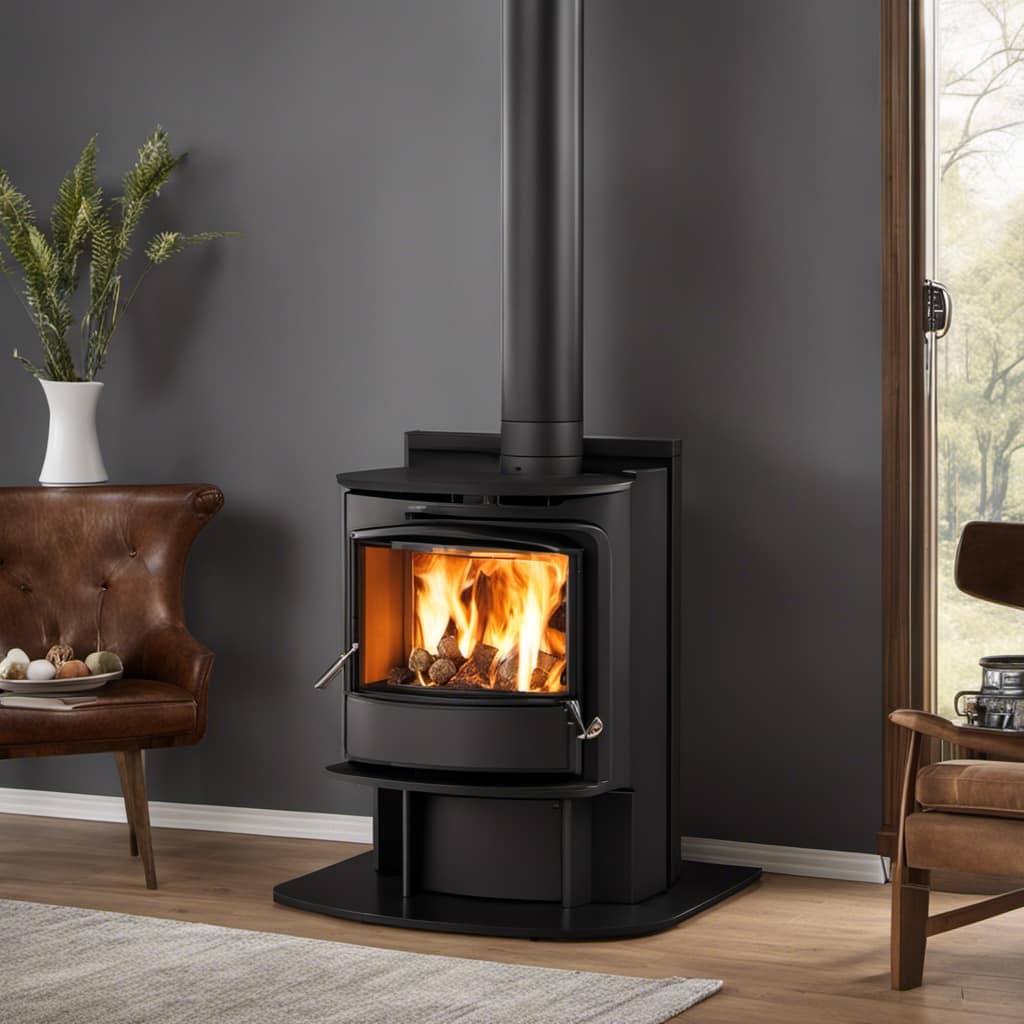The saying “Knowledge is power” holds particularly true when it comes to wood stoves, as being aware of the indicators of overfiring can help avert a possible disaster.
In this article, I’ll guide you through the telltale signs of over firing a wood stove.
From excessive smoke production to damaged firebricks, warped components, blackened glass, and intense heat output, I’ll provide you with the knowledge you need to keep your wood stove operating safely and efficiently.
Key Takeaways
- Unusual or intense heat output can be a sign of overfiring.
- Sooty or blackened glass indicates inconsistent burn rate, which may result from overfiring.
- Insufficient draft can cause intense heat output.
- Regular inspection and maintenance are important to prevent overfiring and its negative effects on stove performance and safety.
Excessive Smoke Production
I can tell if I’m over firing my wood stove when there’s too much smoke. Excessive smoke production is a clear sign of inefficient combustion, which not only affects the performance of the stove but also has a negative environmental impact.

When the wood stove is over fired, it means that the fire is burning too hot and the air supply isn’t properly controlled. This leads to incomplete combustion, resulting in the production of more smoke than necessary. The smoke contains harmful pollutants such as carbon monoxide, nitrogen oxides, and particulate matter, which can contribute to air pollution and have adverse effects on human health.
In addition, the excessive smoke can also create a nuisance for neighbors and contribute to the overall degradation of air quality. Therefore, it’s important to monitor the smoke production and ensure efficient combustion for the optimal operation of a wood stove and to minimize its environmental impact.
Damaged or Cracked Firebricks
My first indication that there may be an issue with the wood stove is when I noticed the damaged or cracked firebricks. Firebricks are an essential component of a wood stove, as they provide insulation and protect the stove’s interior from extreme heat. If they become damaged or cracked, it can lead to several problems, including decreased heat efficiency, increased smoke production, and potential safety hazards.
To address this issue, firebrick replacement and maintenance are necessary. Here are three important things to know about firebrick replacement and maintenance:

Regular Inspection: It’s important to regularly inspect the firebricks for any signs of damage or cracks. This can be done by visually examining the bricks and feeling for any irregularities or loose pieces.
Replacement Process: If you notice any damaged or cracked firebricks, it’s essential to replace them promptly. This can be done by carefully removing the damaged bricks and installing new ones in their place. It’s recommended to consult the stove manufacturer’s guidelines for the correct type and size of firebricks to use.
Maintenance Tips: To extend the lifespan of firebricks, there are a few maintenance tips to keep in mind. Avoid using excessive force when loading wood into the stove, as this can cause damage to the bricks. Additionally, avoid burning materials that produce corrosive or acidic byproducts, as these can erode the firebricks over time.
Warped or Deformed Stove Components
The warped or deformed stove components can affect the overall performance and safety of the wood stove. When the metal parts of the stove become rusty, it can lead to structural weakness and compromised integrity. Rust weakens the metal, making it more prone to breaking or bending, which can cause the stove to malfunction or even collapse.

Additionally, discolored stove parts, such as warped or disfigured panels, can indicate excessive heat exposure. This can be a sign of overfiring, where the stove is subjected to temperatures higher than recommended. Overfiring can cause irreversible damage to the stove, including warping or deforming of the components.
It’s important to regularly inspect and maintain the stove to ensure its proper functioning and safety.
Blackened Glass or Soot Build-Up
The blackened glass or soot build-up on the wood stove indicates a need for cleaning and maintenance. It’s essential to keep the glass clean not only for aesthetic reasons but also for the overall efficiency of the stove. Here are three glass cleaning techniques and tips to prevent soot buildup:
Use a specialized glass cleaner: Choose a cleaner specifically designed for wood stove glass. Avoid using abrasive materials that could scratch the glass surface.

Vinegar and water solution: Mix equal parts of vinegar and water in a spray bottle. Spray the solution onto the glass and let it sit for a few minutes. Scrub gently with a non-abrasive cloth or sponge and rinse with clean water.
Burn seasoned firewood: Burning properly seasoned firewood reduces the chances of excessive soot buildup. Moisture content in wood contributes to creosote and soot formation, so make sure the firewood is dry and well-seasoned.
What Are the Signs of Overfiring a Wood Stove and How Can I Prevent It When Adding a Wood Stove to My House?
When adding a wood stove to your house, watch for signs of overfiring, such as the stove body glowing red or the chimney smoking excessively. To prevent this, use seasoned wood, keep the stove’s air vents open, and follow the manufacturer’s guidelines for proper operation.
Unusual or Intense Heat Output
I noticed that the wood stove is producing an unusually intense amount of heat. As I sat in front of the stove, I could feel the heat radiating off it, almost too much for comfort. This raised some concerns in my mind, as an intense heat output can be a sign of overfiring. I decided to investigate further and check for other signs of overfiring.
To help me analyze the situation, I created a table to compare the observed symptoms with the possible causes:

| Symptoms | Possible Causes |
|---|---|
| Unusually intense heat output | Insufficient draft |
| Sooty or blackened glass | Inconsistent burn rate |
Frequently Asked Questions
Can Over-Firing a Wood Stove Cause a Carbon Monoxide Leak?
Over-firing a wood stove may cause carbon monoxide poisoning. Signs of over firing include excessive smoke, a roaring fire, and rapid consumption of wood. It is important to monitor the stove and ensure proper ventilation to prevent any potential leaks.
How Can I Prevent My Firebricks From Getting Damaged or Cracked?
To prevent firebrick damage and maintain their longevity, it’s important to avoid over-firing your wood stove. Over-firing can cause excessive heat, leading to cracked or damaged firebricks. Regularly monitor the temperature and ensure proper air flow to prevent over-firing.
Is It Possible to Repair or Replace Warped or Deformed Stove Components?
Yes, it is possible to repair or replace warped or deformed stove components. If the stove components are damaged due to over-firing, it is important to address the issue promptly to prevent further damage and ensure safe operation.
What Are Some Effective Methods for Cleaning Blackened Glass or Soot Build-Up on a Wood Stove?
To clean soot from a wood stove’s glass, a mixture of vinegar and water can be used. Apply the solution to the glass and wipe it with a clean cloth. To prevent soot buildup, ensure proper air circulation and burn dry, seasoned wood.

Are There Any Safety Precautions I Should Take if I Notice an Unusual or Intense Heat Output From My Wood Stove?
If I notice an unusual or intense heat output from my wood stove, I should immediately take safety measures. Signs of over firing include excessive smoke, intense flames, and a red-hot stove.
Conclusion
So, my friends, if you find yourself surrounded by a cloud of smoke thicker than a foggy day in London, your firebricks looking like they’ve been through a war, your stove components twisted like a pretzel, your glass blackened like a chimney sweep’s nightmare, and your room feeling like the fiery pits of Mount Doom, well, congratulations!
You’ve successfully over-fired your wood stove. May the heat gods have mercy on your soul.
Growing up surrounded by the vast beauty of nature, Sierra was always drawn to the call of the wild. While others sought the comfort of the familiar, she ventured out, embracing the unpredictable and finding stories in the heartbeat of nature.
At the epicenter of every remarkable venture lies a dynamic team—a fusion of diverse talents, visions, and passions. The essence of Best Small Wood Stoves is crafted and refined by such a trio: Sierra, Logan, and Terra. Their collective expertise has transformed the platform into a leading authority on small wood stoves, radiating warmth and knowledge in equal measure.











